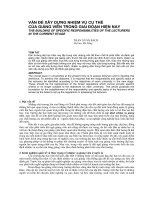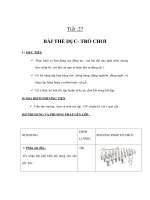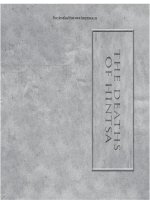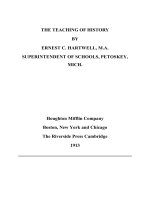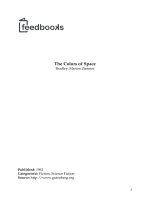The Belgian Blue Breed docx
Bạn đang xem bản rút gọn của tài liệu. Xem và tải ngay bản đầy đủ của tài liệu tại đây (1.09 MB, 17 trang )
1
e Belgian Blue
Breed
2
The Belgian Blue breed represents 50% of the national herd, which is made up of 1.083.408
cows.
EXPANSION OF THE BREED
Whereas full blood Belgian Blue is used in Northern Europe for meat production, its extraor-
dinary quality in crossbreeding programs has enhanced its expansion in the whole world. That
is why we see Belgian Blues in France, in the Netherlands, in Great Britain, in Ireland, in Den-
mark, in USA, in Canada, in Brazil, in Australia, in New-Zealand, in Mexico
Due its exceptional qualities in cross and full
blood breeding, the request for breeding stock
is constantly increasing worldwide.
The Belgian Blue in Australia
61 % of the Belgian Blue livestock is in the Walloon region and 39% in the Flemish part
of Belgium. The Belgian Blue herd is spread all over Belgium. However, it is in the Provinces
of Luxemburg, Hainaut and Western Flanders that the number of Belgian Blue is the most im-
portant.
The breed is perfectly suited to a great diversity of soils and climates encountered in its
international expansion. Its very calm temperament and its docility are also very much
appreciated.
The Belgian Blue in Denmark
D is tribu tio n o f the B B he rd pe r P rovin c e
4%
4%
11%
5%
15%
3%
17%
8%
20%
13%
A ntwerp
Lim bourg
E as tern Flanders
Flam ish B rabant
wes tern F landers
W alloon B rabant
Hainaut
Liège
Lux em bourg
Nam ur
EXPANSION OF THE BREED
3
EXPANSION OF THE BREED
EXPANSION OF THE BREED
In order to establish internationally the recogni-
tion of the Belgian Blue breed, 16 Herd-Book
were created in Europe, America, Asia and in
Australia.
These 16 Herd-Books, members of the BBI, work
together in order to:
• harmonize the methods and criteria of identica-
tion and registration of BBB in the different Herd-
Books;
• keep the registers and registration papers of the
animals exchanged or sold;
• exchange information regarding the breeding of
Belgian Blue;
• favour the exchange of genetics;
• cooperate in the promotion of the Belgian Blue
breed;
• represent internationally the interests of the Bel-
gian Blue.
International meetings, breeding seminars,
exchange of judges, carcass competitions are
notably organized within the framework of this
collaboration.
Thanks to this promotion, the precon
-
ceived ideas about the Belgian Blue
disappear and the breed experiences an
always growing success.
Cattle exhibition at the Houston show (USA)
Belgian Judge : National
Tullamore (Ireland)
Belgian Judge : National
Iowa (USA)
BB Stand, Regina
(Canada)
4
But the watershed occurred between 1960
and 1970.
First for bulls and later for cows, a clear
preference was granted to the muscular de-
velopment. The response to this selection was
remarkable. A new type of breed appeared,
combining signicant muscle development
(shoulders, withers, back, loin, and hind
quarters), size, ne but solid bone structure,
harmonious contours with round ribs, in
-
clined rump, hidden hips and detached tail.
In 1973, the breed, hitherto called «race de
Moyenne et Haute Belgique» was renamed
BELGIAN BLUE BREED divided into 2
distinct branches: the meaty type and the dual
purpose type.
ORIGIN AND EVOLUTION OF THE BREED
from fairly uniform local cattle and the very
popular Sorthorns widely used in the second
part of the 19
th
century.
However, everything was called into question
when the First World War broke out.
It was only in 1919 that an Agricultural
Charter was developed in the form of a Royal
Decree which paved the way for further
breed development.
The selection work started up again, but
with a clear objective: a rectangular «dual
purpose» breed of cattle, with a good stat-
ure, average muscle structure and good milk
production (4.000 litres at 3.5%).
1902
This trend was rmly maintained until 1950.
One has to go back
to the beginning of
the past century to
see the rst selection
attempts to breed a
dual purpose animal
1930
1965
The years from 1950 to 1960 were a period
of transition, during which the early signs of
a new orientation became clearly visible.
1940
Beginning XX
ème
century
1975
ORIGIN AND EVOLUTION OF THE BREED
5
ORIGIN AND EVOLUTION OF THE BREED ORIGIN AND EVOLUTION OF THE BREED
Certain breeders have continued to select
animals for combined milk and meat pro-
duction. This selection developed paral-
lel to the meaty type’s one, by using com
-
pletely different blood lines. The «Bleue du
Nord» type belongs to the same group and
is found in the Maubeuge region in France.
With the establishment in 1999 of the agri-en
-
vironmental measurement plan for the protec-
tion of endangered species, the interest for this
dual purpose branch has been growing and
as of 2005, more or less 150 breeders use the
dual purpose Belgian Blue type in Belgium.
They are located in the Provinces of Hainaut
and Brabant. Within the dual purpose type, 2
variants are identied according to the geno-
type:
Belgian Blue Breed
DUAL PURPOSE type
MEATY type
genotype
mh/+ or +/+
genotype mh/mh*
These animals are
genetically identical to
the meaty type ones.
However their selec
-
tion is also based on
the milk production
and the easy-calving.
Their milk production
varies between 4200
and 4800 litres.
These animals of dairy
type produce on aver
-
age from 5400 to 6000
litres of milk.
The selection of double muscled cattle
responses to the economic climate and in
particular, to the demand of a meat industry
very sensitive to the muscle conformation,
reecting the composition of the carcass. The
increased prot linked to well muscled cat-
tle pushes the breeders to mate the meatiest
animals to each other.
From an originally dual purpose breed, the
Belgian Blue has become a specic breed
of beef cattle, with the following traits and
benets: extraordinary muscle development,
desirable meat quality (tenderness), stature,
early maturity, feed efciency, docility, uni-
formity and maternal aptitudes.
* mh : muscular hy
-
pertrophy gene
6
cHARAcTERISTIcS OF THE BREED
STATURE
COAT
Apart from the «pie» character (recessive vis-à-vis «all colored»)
present in most colored animals, three color types are typical for
the breed: all white, blue (pie-blue) and black (pie-black). These
3 phenotypes correspond to the isolation of a gene pair inherited
from the Shorthorns. The blue (equivalent to the roan in Short
-
horns) is the intermediate, heterozygote phenotype.
Among these 3 phenotypes, the black one is the least popular in
Belgium.
Parental Combinations
Composition of the descendants
White Blue Black
White X White 100 %
White X Blue 50 % 50 %
White X Black 100 %
Blue X Blue 25 % 50 % 25 %
Blue X Black 50 % 50 %
Black X Black 100 %
The weight of an adult bull ranges from between 1.100 and 1.250
kg, for a height at the withers of about 1m45 to 1m50. Indeed, it
is by no means rare to see animals heavier than 1.300 kg.
The average weight of an adult cow at the beginning of pregnancy is 700 - 750 kg, with a
height at withers of 132 to 134 cm. Cows can reach a weight of 850 to 900 kg and can exceed
140 cm.
Age in months 12 24 36 48 60
Weight (kg)
1
st
category 500 770 970 1111 1136
All categories
484 752 966 1111
Height (cm)
1
st
category 120.4 134 142.2 145.8
All categories 120.2 134.8 141.7 145
Weight and height of bulls measured at ofcial events
Height of breeding cows
Age in months 18 24 36 48 60
Height (cm)
females presented at
ofcial events
124.6 130.4 133.1 134.6
breed’s average
(linear score)
117.9 123.3 127.9 130.4 132.4
Nevertheless, in Scotland for instance, the black Belgian Blue bulls are popular for crossing on
Angus cows.
cHARAcTERISTIcS OF THE BREED
7
cHARAcTERISTIcS OF THE BREED
cHARAcTERISTIcS OF THE BREED
DAILY GAIN
FEED EFFICIENCY
The higher rate is mostly due to a protein weight gain and weak fat gain. The feed conver-
sion rate is in the 5 kg range from 7 to 13 months. Given its low propensity to deposit fats, the
«meaty» animals can be raised and «fattened» on a diet rich in energy which leads to higher
weights without excess fats. The traditional formula is to produce 18 to 19 month old bulls
weighing around 650 kg.
The Average Daily Gain (ADG) of bulls from 7 to 13 months
measured at the Bovine Selection Station (bulls calves in
-
tended for breeding) reaches 1.6 kg/day.
In fattening, the ADG of bulls rises to 1.2 kg.
The feed conversion rate (kg of feed by kg growth) is sys
-
tematically better with the Belgian Blue. This cattle con-
sumes less and transforms more efciently.
KILLING-OUT PERCENTAGE
CARCASS COmPOSITION
The average killing out percentage of the Belgian Blue animals
reaches at least 70%. With a carcass yield of 82% or more, these
animals provide, for the same liveweight of 600kg for example,
100 kg more meat than animals with a 60% killing-out.
In Belgium, 70% of young cattle fall in the S and E categories
(of the European classication system), while in the other E.U.
countries, the majority belongs to the U, R and O classes. The
Belgian Blue breed produces a lot of meat while causing very
little waste.
In the hands of skilled Belgian butchers muscles that typically
give 2
nd
grade cuts are reclassied as 1
st
grade cuts which increas-
es the yield of consumer-prized fast-cooking pieces by 35%.
8
cHARAcTERISTIcS OF THE BREED
mEAT QUALITY
The Belgian Blue breed has been selected
by the breeders to satisfy the consumer’s
expectations. Statistics show that in Bel-
gium each person consumes on average
100 kg meat per year, of which 20 kg of
bovine meat. The Belgian Blue contrib-
utes 75% of the red meat production.
The breed is not only characterized by the
quantity of produced meat but also by its
quality.
The Belgian Blue meat is recommended by doctors and dieticians. Indeed, it contains less cho
-
lesterol (+/- 45 mg/100g) than skinless chicken meat (+/- 62 mg/100g).
Moreover the BB meat contains on average 5% fat, that is to say 2 to 3 times less than the meat
produced by other breeds. Its lipid composition is characterized by a good fatty acids balance;
fat of such quality is not unhealthy.
The meat is very tender because of the ner bres and lower percentage of tough connective
tissue.
Belgian Blue meats require about 1/3 less cooking time than standard beef.
Belgian Blues offer consumers ex
-
actly what they want: naturally lean,
tender and tasty meat, produced
with respect for the animal wellbe-
ing and the food safety.
Its high nutritional value is determined by 4 main elements : the meat is rich in high biological
quality protein, in vitamins B3 and B12, in iron and zinc, both being on an easily assimilated
form.
cHARAcTERISTIcS OF THE BREED
9
cHARAcTERISTIcS OF THE BREED
cHARAcTERISTIcS OF THE BREED
ZOOTEChNICAL QUALITIES
• AGE AT 1
ST
CALVING:
Female Belgian Blues are precocious and
reach puberty earlier than the females of other
beef breeds. The average age at 1st calving is
29-30 months. However, in many herds, the
heifers calve at 24 months.
They are therefore fed intensively until their
rst calving.
• GESTATION AND TWIN BIRTHS:
The Belgian Blue Breed belongs to the group
of breeds with relatively short gestation peri-
ods. For the male fetus, it is 282.6 days and for
the female fetus, 281.6 days.
Frequency of twins is 2.3% on average.
• BIRTH WEIGHT:
The birth weight of male calves is on average
47 kg. Female calves weight 44 kg at birth.
• CALVING INTERVAL :
The average interval is 14 months; for 75%
of cows, it ranges from between 11 and 15
months.
• A.I NON-RETURN RATE:
In Belgium, approximately 50% of the cows
are bred through articial insemination. The
non return rate at 58 days is 69.7%
• CALVING ISSUES :
At birth, the young «meaty» type calf can be
worth twice if not three times as much as an
ordinary calf. The value of a «meaty» calf is
such that the breeder can no longer take any
risks and systematically opts for an easy calv-
ing by Caesarean Section, which is considered
as a technical choice, thereby preventing any
traction what limits the perinatal mortality.
Comparative tests carried out in various Euro
-
pean countries on Friesians, Hereford, Aber-
deen Angus have shown that the proportion
of assisted calving is more or less identical to
that observed for other European breeds of beef
cattle. (Limousine, Blonde d’Aquitaine ).
10
SELEcTION AND
TESTING PROGRAMS
In Belgium, selection based on the animal’s appearance and conformation has been practised
for many years and with much success. Our breeders have thus developed the Brabançon and
Ardennes working horses, the Pietrain pig, the Belgian Landrace pig, the Beltex sheep and of
course the Belgian Blue Beef cattle.
Today, the goal is to keep the superior muscling which allows the Belgian Blue to differentiate
it self from other beef cattle, and through selection maintaining rusticity, size, posture, feet and
legs
Belgian Blue breeders created the Belgian Blue Herd-Book, which is entrusted with the selec-
tion, the registry of pedigrees and the promotion of the breed.
In Belgium, the number of active Belgian Blue breeders is around 2.000. The number of regis-
tered cows is 90.000 and that of registered bulls 2.500. Some 33.500 females and 1.900 males
are registered annually in the Herd-Book.
Parallel to the traditional selection methods which consists in choosing the good mating based
on their pedigree and the classication at ofcial competitions, a wide-range A.I. bull testing
program has been set up.
HERDS
REGISTRATIONS AT BIRTH
Ofcial inspections
HB registrations
Linear scoring 10-18 months
FARMS
Inspection and HB registra
-
tion 10-24 months
Linear scoring 15-56 months
A.I.
PROGENY TEST
450 M
PERFORMANCE
TEST STATION
(250 M successful)
M + F 64.000
M 1.000
F 34.000
F 35.000
F = females
M = males
SELEcTION AND
TESTING PROGRAMS
11
SELEcTION AND
TESTING PROGRAMS
PERFORmANCE -TEST
SELEcTION AND
TESTING PROGRAMS
Bulls from the performance-test are the result of preferen-
tial matings between A.I. or private bulls labelled as «bull
fathers» and specially-chosen cows, most notably through
their linear classication, and labelled as «bull mothers».
PROGENY -TEST
The Progeny-Test involves the offspring of all A.I. sires.
Results (genetic evaluations) from these farm-based progeny tests are
published biannually. At the farm the controls start at calving (1st
visit), and the calves are reexamined at 14 months of age (2nd visit).
The collected data reects the following zootechnical and functional
traits:
Average performances at the Station.
Weight Height
Daily
Gain
Feed Ef-
ciency
Value
(€ /kg)
Auction Categ.
544.55 120.5 1.558 4.966 3.00
Admitted
return in farms
525.3 119 1.547 5.115 2.90
Refused 531.7 119 1.562 4.886 3.00
– 1st visit (birth): gestation length, birth
weight, conformation, possible legs and
mouth defects, vitality, death rate
– 2nd visit (14 months): weight,
height, combined index weight-conformation,
possible legs and mouth defects, death rate.
At the age of 13 months, a severe selection takes
place since only 50 % of the potential candidates
are accepted for public auction where breeders
and A.I. stations may bid for the bulls.
If these male calves meet the sanitary requirements, they are
allowed into the Test-Station where they are raised in identical
conditions until the age of 13 months.
The young bulls are subjected to daily gain, feed
consumption and spermatogenesis evaluations.
12
SELEcTION AND
TESTING PROGRAMS
LINEAR SCORE
A special system of linear scoring has been
developed by the Belgian Blue Herd-Book
for the breed. This evaluation is systematic
for all the registered cows from 15 to 56
months of age.
The linear classication involves numeri-
cally scoring of each animal as to its mor-
phology based on 22 traits : 4 for the size of
the animal, 9 for the muscle development
and 9 for the bone structure and posture.
The linear score allows for:
• a periodic inventory of the morphological characteristics of the herd, whether this
concerns a specic herd or the breed as a whole;
• the choice of bulls-mothers, with the purpose to enter male calves into the Bovine
Selection station;
• the selection of future embryo donor cows;
• an highly specic genetic evaluation of the A.I. bulls.
Moreover, possible legs defects are taken in account: deviation rear- or forelegs, fetlock rear- or
forelegs, sagged knee, puffy hocks.
THE BELGIAN BLUE IN cROSS BREEDING
13
SELEcTION AND
TESTING PROGRAMS
THE BELGIAN BLUE IN cROSS BREEDING
The terminal cross breeding (crossbred animals intended for the meat production and not for
breeding) is more and more popular in many regions of the world. The introduction of the Eu
-
ropean classication system «SEUROP» is seen to be at the origin of this enthusiasm.
Given its economical and meat qualities, the BB is often chosen as terminal sire.
In many countries, trials of crossing between the Belgian Blue sire and local breed cows were
carried out. As a general rule, they reveal the superiority of the BB crossbred calf resulting in
increased growth, feed efciency and above all muscle conformation.
A Belgian Blue cross on a Holstein type dairy
cow, offers a marked improvement in kill
-
ing out (+4 to 5%) and in carcass meat yield
(+8%). This benet is not accompanied by any
more calving problem than found with most
other beef breeds.
In a series of tests performed on crossbreds by the United States Department of Agriculture’s
Clay Center (MARC) involving the most popular beef breeds (Angus and Hereford), the Bel
-
gian Blue crossbred carcass yield surpassed the control subjects [(Angus X Hereford) X (Angus
X Hereford)] by 1.7%, percentage of lean by 6.7% and fat content lower by 7.4%. All told, the
Belgian Blue crosses yielded 31.2 kg more meat and 25.1 kg less fat, on average, than Angus
X Hereford.
Moreover, the survival rate, the daily gain and the feed efciency are also better for the Belgian
Blue crossbreds. Their great carcass quality justies a better price on the market
(the average added value per calf reaches 200€).
In addition, the white coloured Belgian Blue bull «marks» its offspring, with these being en-
tirely “blue” on Holstein cows.
[BB X Holstein Frisian] in Great Britain
[ BB X ( X Simmental)] in Czech Republic
[ BB X Angus ] in Canada
[ BB X South Devon] in USA
14
Breeding a dairy or a beef cow to a Belgian
Blue produces a Belgian Blue crossbred sig-
nicantly better than the maternal breed: better
carcass yield, leaner meat, less fat, better feed
conversion rate
The BB is also much appreciated to mellow the
nervous character of certain local breeds.
Taste-testing has shown that for steak there ap
-
pears to be no racial difference with respect to
«juiciness», avour and tenderness. In roasts,
however, the Belgian Blue was more tender
than all other breeds.
In Brazil and Argentina, the BBB is used on a
large scale to tenderize the Zebu meat.
THE BELGIAN BLUE IN cROSS BREEDING
[ BB X Jersey] in Great Britain
[ BB X Zebu Nelore] in Brazil
BBB X
RDM
RDM Diff
BBB X
HOL
HOL Diff
BBB X
JER
JER Diff
Age, months. 14.4 14.1 0.3 14.4 14.0 0.4 14.3 14.9 -0.6
Carcass, kg. 283 251 32 288 244
44 248 189 59
Score, carcass
quality, EUROP
8.2
4.7 3.5 8.4 3.9 4.5 6.8 3.1 3.7
ADG, g/day
594 542 52 608 526 82 524 384 140
Some results:
• Denmark : Slaughtering, carcass quality and ADG results of bulls from various
crossings: BB X Danish Red (RDM), BB X Holstein and BB X Jersey. Slaughtering carried
out between 1999 and 2003.
•
Italia : Fattening results of crossbred male calves, slaughtered at the age of 4 months.
Holstein X BB
Holstein X Limousin
Holstein X Italian
Simmental
Final Weight (kg) 120.80 118.19 119.81
ADG (g/day)
848 774 811
Feed gain ratio (g. D.M. food/g
ADG)
1 967 2 121 2 002
THE BELGIAN BLUE IN cROSSING
15
THE BELGIAN BLUE IN cROSS BREEDING
THE BELGIAN BLUE IN cROSSING
[ BB X Bl. Aquitaine ]
[ BB X Limousin ]
[ BB X Charolais]
[ BB X Montbeliard ]
[ BB X Normand] [ BB X Red Holstein ]
16
STANDARD FEATURES
hEAD
Fine-featured, well proportioned, fairly wide, at forehead, large mufe. The head is bigger,
shorter and more massive in the male.
Short, horizontal horns, at the side in the bull, curved forwards from the forehead in the cow.
Defects: fairly unrened, long and tapering head.
NECK
Thick and horizontal in the cow; convex and rounded in the bull.
ShOULDER
Well muscled, in proportion to the surrounding areas. The muscle structure of the shoulder, leg,
foreleg and the scapula-humeral angle are particularly well-developed in the bull.
Defects: protruding and detached shoulders, insufcient muscle structure.
wIThERS
Wide and musclular withers, in a straight line with the neck and with the back, at least in the
cow.
Defects: narrow, insufciently muscular withers, not properly attached to the back.
bACK AND LUmbAR REGION (KIDNEYS)
Horizontal, wide and muscular, convex ridge in the middle of the back which can continue to
the hindquarters (double kidneys).
Defects: saddle-back, insufcient muscle structure, kidney not properly attached, protruding
backbone.
ChEST
Rounded ribs, thick muscle cover to the rear of the shoulder, especially in the male. Wide and
muscular chest above all in the bull. Thin and pliable skin, fetlock not very developed.
Defects: at, long rib, narrow chest, thick skin.
FLANK
Short and full, the fold of the groin continues towards the front; resulting in a very thick «extra
fold of skin» (corde).
Defects: long, hollow, sagging abdominal wall.
CROUP (RUmP)
Wide with disappearing hips, long, inclined, highly developed muscle structure (double), espe-
cially in the male, the median hollow being occupied by the sacrum which in turn is prolonged
by the tail, which is prominently set.
Defects: too short, narrow, insufciently muscular and inclined rump, embedded tail set.
STANDARD FEATURES
17
STANDARD FEATURES
STANDARD FEATURES
bUTTOCKS
AND ThIGhS
1
Rounded and convex with apparent intermuscular ssures; in prole:
starting out at the ischial point, the thighs prolong the rump to the rear
in a circular arc and overhang the hocks and its tendon; in the male,
looked at front on from behind, the contour from the top of the croup
and the bottom of the buttocks tends to have an arching line.
Defects: insufcient muscle structure, buttocks too short.
TAIL
Development in relation with the bone structure, average length, falls perpendicularly.
Defects: tail too short, embedded tail set.
bONE STRUCTURE AND STANDS
Solid and fairly delicate bone structure, dry and exible joints, healthy and tough hooves.
Defects: unrened bone structure, stiff joints which may have thickened and can even be swol-
len.
forelegs:
• In prole, forearm, knee and cannon form a straight column.
Defects: forelegs too far forward, forelegs too far backward, arched knee.
• Front view, forearm and cannon form an open angle with the knee at the top.
Defects: forelegs turned-in feet (open knee), forelegs turned-out feet (knock-knee)
rearlegs:
• In prole, a lowered perpendicular line from the ischial point to the top of the hock.
Defects: angle of the hocks too open (straight hocks), angle of the hocks too closed
(bent hocks).
• Seen from behind, hind legs in parallel with the centre of the body.
Defects: turned-in feet (open), turned-out feet (cow-hocked).
Pasterns:
Continues up from the hooves, from the crown to the ankle; the pastern is naturally
straighter in the hind leg.
Defects: pasterns too short (insufciently inclined), too long (excessively inclined
pasterns).
UDDER
Square, symmetrical, averagely well developed, well placed teats.
Defects: drooping udder, bottle-shaped udder (goat’s udder), tits set too closely together.
TESTICLES
Normal size.
Defects: too small, swollen, absent (cryptorchidy).
1. Buttocks : region from the
ischial point to the tendon
which is attached to the
hocks.
Thigh : in relation with the
femur; is limited to the front
by the ank, and to the rear
by the buttocks.
